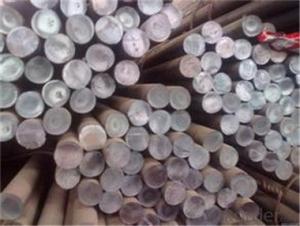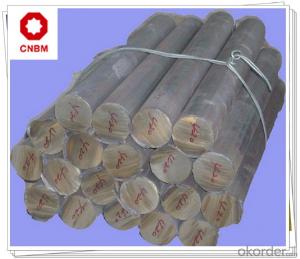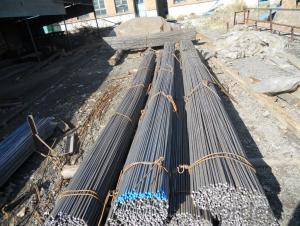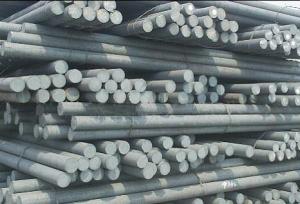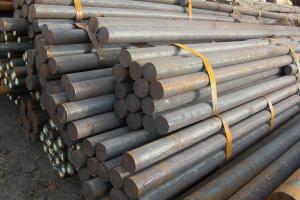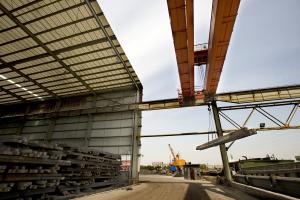Hot Rolled Steel Rod Price Steel Round Bar China
- Loading Port:
- Tianjin
- Payment Terms:
- TT OR LC
- Min Order Qty:
- 990 m.t.
- Supply Capability:
- 2000000 m.t./month
OKorder Service Pledge
OKorder Financial Service
You Might Also Like
Description of steel round bar:
(1) Thickness of not more than 2MM sheet, efficient blanking die, punch die and pressure die etc.
(2) All kinds of scissors, inserts, woodworking blade.It is used in the manufacture of a higher strength and higher quenching and tempering section of the 35CrMo steel, like big locomotive traction gears, supercharger drive gear, rear axle, the connecting rod and the spring load greatly clip,
Festures of steel round bar:
1.Dia 80-800mm Length:2000-13000mm or as required
2.Technique:Forged
3.Delivery Time:45 days
Specifications of steel round bar:
Round bar | Diameter(mm) | Length (mm) | |
10~800 | 2000~5800 | ||
plate/sheet | Thickness(mm) | Width (mm) | Length (mm) |
10~800 | 80~2300 | 2000~5800
|
Images of steel round bar:
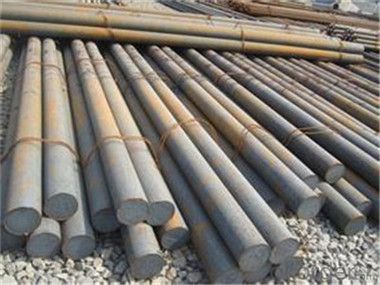
FAQ:
1. What is your package?
Packing situation: standard seaworthy packing or as customer required.
2. How long is the lead time?
Delivery time: 45 days after order confirmed.
3. What payment term do you accept?
Payment: T/T or L/C at sight.
- Q: What are the advantages of using zinc-alloy steel round bars?
- There are several advantages of using zinc-alloy steel round bars: 1. Corrosion resistance: Zinc-alloy steel round bars are coated with a layer of zinc, which acts as a protective barrier against corrosion. This makes them highly resistant to rust and other forms of corrosion, ensuring a longer lifespan and durability. 2. Strength and durability: Zinc-alloy steel is known for its high strength and durability. The addition of zinc to the steel enhances its structural integrity, making it capable of withstanding heavy loads and high stress conditions. This makes zinc-alloy steel round bars suitable for various applications that require strength and reliability. 3. Cost-effective: Zinc-alloy steel round bars are cost-effective compared to other corrosion-resistant materials. The zinc coating provides a cheaper alternative to expensive metals like stainless steel, while still offering comparable corrosion resistance and strength. 4. Easy fabrication and versatility: Zinc-alloy steel round bars can be easily fabricated into different shapes and sizes, making them versatile for various applications. They can be cut, bent, welded, and machined to meet specific requirements, making them suitable for use in construction, automotive, industrial, and other industries. 5. Aesthetic appeal: Zinc-alloy steel round bars have a visually appealing appearance due to their shiny and smooth zinc coating. This makes them suitable for applications where aesthetics are important, such as architectural designs or decorative elements. 6. Environmental sustainability: Zinc is a highly recyclable material, and the use of zinc-alloy steel round bars promotes environmental sustainability. These bars can be recycled at the end of their lifespan, reducing the need for new raw materials and minimizing waste generation. Overall, the advantages of using zinc-alloy steel round bars include corrosion resistance, strength, cost-effectiveness, versatility, aesthetic appeal, and environmental sustainability. These qualities make them a desirable choice for various industries and applications.
- Q: How are steel round bars used in the manufacturing of material handling equipment?
- Material handling equipment commonly incorporates steel round bars due to their strength and durability. These bars are integral components in the construction of equipment such as cranes, forklifts, conveyors, and hoists. A primary application of steel round bars in material handling equipment is their use in load-bearing structures. They are specifically utilized in the construction of masts, booms, and jibs of cranes and hoists, as these components must endure heavy loads and provide stability. Steel's high tensile strength and resistance to bending make it an optimal choice for these critical parts. In addition, steel round bars are employed for shafts and axles in material handling equipment. These components play a vital role in transmitting power and torque, facilitating efficient equipment operation. Steel's ability to withstand substantial stress and torsional forces makes it an ideal material for these purposes. Steel round bars are also commonly utilized in the fabrication of lifting attachments and hooks for material handling equipment. These bars are skillfully shaped and welded to create the necessary lifting mechanisms, ensuring safe and secure transportation of heavy loads. Steel's strength and rigidity enable it to withstand the forces exerted during lifting operations. Furthermore, steel round bars find application in the manufacturing of conveyor systems. These bars function as rollers or shafts, supporting and guiding the movement of materials along conveyor belts. The smooth surface of steel bars minimizes friction, enabling efficient material handling. In conclusion, steel round bars are indispensable in the manufacturing of material handling equipment. Their strength, durability, and versatility render them suitable for a wide range of applications, including load-bearing structures, shafts, lifting attachments, and conveyor systems.
- Q: How are steel round bars used in the construction of high-rise buildings?
- Due to their strength, durability, and versatility, steel round bars are commonly utilized in the construction of high-rise buildings. Carbon steel is typically used to manufacture these bars because it possesses excellent mechanical properties and can endure high loads and pressures. In reinforced concrete structures for high-rise buildings, steel round bars are primarily employed. They serve as reinforcement in concrete beams, columns, and slabs. By embedding the bars in the concrete, the overall structure gains added strength and stiffness. One of the main benefits of utilizing steel round bars is their ability to withstand tension forces. Concrete is strong in compression but weak in tension. Therefore, the steel bars act as tension reinforcement, preventing the concrete from cracking or failing when subjected to tension loads. This significantly improves the building's structural integrity and overall safety. Moreover, steel round bars offer easy bending, shaping, and welding, allowing for flexible design and construction options. They can be customized to specific lengths and diameters to meet the requirements of the building project. This adaptability makes them ideal for constructing various structural elements, like beams and columns, which must be precisely engineered to support the weight and stresses of a high-rise building. Furthermore, steel round bars exhibit excellent resistance to corrosion, which proves crucial when constructing high-rise buildings exposed to various environmental elements. The steel's corrosion-resistant properties ensure the structure's long-term durability and lifespan. In conclusion, steel round bars are essential in the construction of high-rise buildings as they provide strength, durability, and flexibility to reinforced concrete structures. They enhance the overall structural integrity, safety, and longevity of the building, making them a crucial component in modern construction practices.
- Q: Can steel round bars be bent?
- Yes, steel round bars can be bent. The flexibility of steel allows it to be shaped and manipulated into various forms, including bending round bars into desired angles or curves.
- Q: What is the difference between a hot-rolled and a cold-drawn steel round bar?
- The main difference between a hot-rolled and a cold-drawn steel round bar lies in the manufacturing process. Hot-rolled steel round bars are formed by heating and rolling the steel at high temperatures, resulting in a rougher surface finish and less precise dimensions. On the other hand, cold-drawn steel round bars are formed by pulling the steel through a die at room temperature, resulting in a smoother surface finish and more precise dimensions. Cold-drawn steel round bars also tend to have improved mechanical properties and a higher strength-to-weight ratio compared to hot-rolled steel round bars.
- Q: What is the difference between a bright and a black steel round bar?
- The main difference between a bright and a black steel round bar is the surface finish. A bright steel round bar has a smooth and shiny surface due to the additional processing steps it undergoes, such as pickling or cold drawing. On the other hand, a black steel round bar has a rough and dark surface due to the absence of these additional processing steps. Additionally, the black steel round bar may also have a coating of oil or rust inhibitor to protect it from corrosion.
- Q: Embedded bolts M24 why use M25 round steel?
- Such as using 24 of the round steel, worried about the surface quality of steel when the processing can not be nominal diameter 24 of the standard thread, of course, the election is too large and wasteful, so generally choose 25 of the round bar,
- Q: What are the different types of corrosion-resistant steel round bars?
- There are several types of corrosion-resistant steel round bars available in the market, including stainless steel round bars (such as austenitic, ferritic, and martensitic stainless steel), duplex stainless steel round bars, and precipitation-hardening stainless steel round bars. These different types of steel round bars offer varying levels of corrosion resistance, strength, and other properties to suit different applications and environments.
- Q: Can steel round bars be used for making pipelines?
- Yes, steel round bars can be used for making pipelines. They are often used as the main material for pipelines due to their high strength and durability, which enables them to withstand the pressure and environmental conditions that pipelines are exposed to. Additionally, steel round bars can be easily welded together to create a continuous pipeline, ensuring a reliable and efficient transportation system for various fluids or gases.
- Q: Can steel round bars be recycled?
- Yes, steel round bars can be recycled. Steel is a highly recyclable material, and this includes steel round bars. Recycling steel round bars involves collecting the scrap material, melting it down, and then reshaping it into new steel products. This process can be done repeatedly without compromising the quality or strength of the steel. Recycling steel round bars not only conserves natural resources but also reduces energy consumption and greenhouse gas emissions compared to producing new steel. It is an environmentally friendly option that helps to promote sustainability and reduce waste.
Send your message to us
Hot Rolled Steel Rod Price Steel Round Bar China
- Loading Port:
- Tianjin
- Payment Terms:
- TT OR LC
- Min Order Qty:
- 990 m.t.
- Supply Capability:
- 2000000 m.t./month
OKorder Service Pledge
OKorder Financial Service
Similar products
Hot products
Hot Searches
Related keywords


